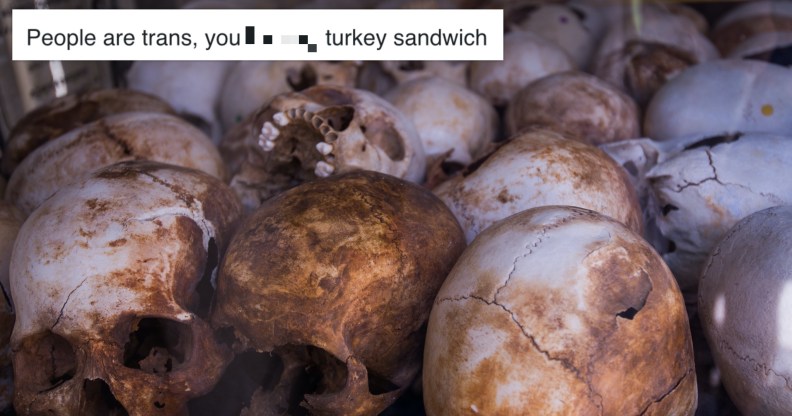Scientists are baffled about a ‘female’ skeleton found in a male-only Greek mountain despite the fact that trans people literally exist

Scientists are stumped over a skeleton sexed as female found in an all-male Greek mountain, despite how trans people exist. (Stock photo via Elements Envato)
Scientists are stumped over a skeleton sexed as female found in an all-male Greek mountain, despite how trans people exist. (Stock photo via Elements Envato)
Scientists are apparently struggling to work out why a “female” skeleton was found in a “male-only” Greek mountain despite the literal fact that trans people exist.
In the unwanted sequel to ‘Two ancient Roman skeletons holding hands that can’t possibly be gay’, the bones of an alleged female were unearthed by excavators at Mount Athos, a historically all-male monastic republic, The Guardian reported.
Researchers are stumped, however. How could a “female” have gotten into the byzantine chapel?
Yet, as a number of Twitter users pointed out, trans people have existed throughout history and the possibility that the person was trans should not be crossed out.
Skeleton sexed as female found in ‘all-male’ Greek chapel perplexes historians and archaeologists.
Archaeologists discovered a set of bones they noted are too small to belong to men of the era.
“Among them were a forearm, shinbone and sacrum that were just so different in their morphology,” archaeologist Laura Wynn-Antikas said.
“While the others were more robust and had clearly belonged to the frames of men, these had measurements that noticeably fell in the range of a female. They were markedly different in size.”
The set of bones were found in the chapel of St Athanasios which belongs to the monastery of Pantokrator.
Monks recommended the bones be radio carbon-dated, considering that women have been barred from the northern Greece peninsula since its foundation in the 10th century.
“If we are talking about a woman, or indeed more than one woman, it will raise a lot of questions,” Wynn-Antikas said.
“Starting with who could she have possibly been.”
‘There is no sodding mystery’: LGBT+ Twitter reminds historians that trans people exist.
However, sexing skeletons has long been an inaccurate method, some historians claim, and often throws trans, non-binary and intersex folk throughout history to the margins.
Moreover, while the results of the carbon dating remain to be confirmed, there is a long and vivid history of trans people existing in ancient Greece.
For example, as early as around 200BCE, priests would worship deities such as Cybele and Attis who identified as women and often castrated themselves. As a result, many historians view them as early trans figures.
What’s more, the concept of a third gender belong the blind binary can be found in Plato’s Symposium, written around the 4th century BC.
In the text, Aristophanes relates a creation myth involving three original sexes: female, male and androgynous.
Twitter schooled the assumption that the skeleton must be female:
https://twitter.com/starchytragedy/status/1206526810319663104
One user wrote: “I literally studied primary sources from the late Roman era talking about AFAB people living as (male) monks, so it’s been a known thing for nearly 2000 years, there is no sodding mystery.
“Seriously, it’s a noted and well recorded thing that’s a taught subject.”
While a number of suers pinned their own examples of trans people’s presence in history:
I'm not the OP and I dunno what they were thinking of exactly but I am a religious scholar and I remembered this quote from the Apophthegmata. This is about 1500 years old? Tip of the iceberg I'm sure but this is the very dawn of the concept of a 'monk'. pic.twitter.com/b5wdqbIvrT
— Nearlynoon!! (@nearlynoon) December 16, 2019
Other users wee hopeful that the idea that the person may have been trans could be proven, adding a new piece to LGBT+ history.
https://twitter.com/starchytragedy/status/1206609005075976192

